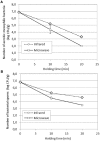A comparative study of infrared and microwave heating for microbial decontamination of paprika powder
- PMID: 26483783
- PMCID: PMC4588691
- DOI: 10.3389/fmicb.2015.01071
A comparative study of infrared and microwave heating for microbial decontamination of paprika powder
Abstract
There is currently a need in developing new decontamination technologies for spices due to limitations of existing technologies, mainly regarding their effects on spices' sensory quality. In the search of new decontamination solutions, it is of interest to compare different technologies, to provide the industry with knowledge for taking decisions concerning appropriate decontamination technologies for spices. The present study compares infrared (IR) and microwave decontamination of naturally contaminated paprika powder after adjustment of water activity to 0.88. IR respectively microwave heating was applied to quickly heat up paprika powder to 98°C, after which the paprika sample was transferred to a conventional oven set at 98°C to keep the temperature constant during a holding time up to 20 min. In the present experimental set-up microwave treatment at 98°C for 20 min resulted in a reduction of 4.8 log units of the total number of mesophilic bacteria, while the IR treatment showed a 1 log unit lower reduction for the corresponding temperature and treatment time. Microwave and IR heating created different temperature profiles and moisture distribution within the paprika sample during the heating up part of the process, which is likely to have influenced the decontamination efficiency. The results of this study are used to discuss the difficulties in comparing two thermal technologies on equal conditions due to differences in their heating mechanisms.
Keywords: infrared heating; microbial decontamination; microwave heating; paprika powder; quality.
Figures





Similar articles
-
Dry pasteurization of paprika (Capsicum annuum L.) by short time intensive microwave-infrared radiation: Inactivation of Salmonella Typhimurium and Aspergillus flavus considering quality degradation kinetics.Food Chem. 2021 Feb 15;338:128012. doi: 10.1016/j.foodchem.2020.128012. Epub 2020 Sep 6. Food Chem. 2021. PMID: 32927202
-
Infrared decontamination of oregano: effects on Bacillus cereus spores, water activity, color, and volatile compounds.J Food Sci. 2014 Dec;79(12):E2447-55. doi: 10.1111/1750-3841.12694. Epub 2014 Nov 12. J Food Sci. 2014. PMID: 25393824
-
Microbial decontamination of onion powder using microwave-powered cold plasma treatments.Food Microbiol. 2017 Apr;62:112-123. doi: 10.1016/j.fm.2016.10.006. Epub 2016 Oct 3. Food Microbiol. 2017. PMID: 27889137
-
Thermal Decontamination Technologies for Microorganisms and Mycotoxins in Low-Moisture Foods.Annu Rev Food Sci Technol. 2021 Mar 25;12:287-305. doi: 10.1146/annurev-food-062220-112934. Epub 2020 Dec 14. Annu Rev Food Sci Technol. 2021. PMID: 33317321 Review.
-
Effects of infrared heating as an emerging thermal technology on physicochemical properties of foods.Crit Rev Food Sci Nutr. 2023;63(24):6840-6859. doi: 10.1080/10408398.2022.2043820. Epub 2022 Feb 28. Crit Rev Food Sci Nutr. 2023. PMID: 35225100 Review.
Cited by
-
Validation of γ-radiation and their effect on phenolic compounds, antioxidant activity, and microbial load of fennel (Foeniculum vulgare) seeds and cinnamon (Cinnamomum verum) sticks.Food Sci Nutr. 2023 Jan 27;11(4):1994-2001. doi: 10.1002/fsn3.3233. eCollection 2023 Apr. Food Sci Nutr. 2023. PMID: 37051350 Free PMC article.
-
Development of Vacuum-Steam Combination Heating System for Pasteurization of Sprout Barley Powder.Foods. 2022 Oct 28;11(21):3425. doi: 10.3390/foods11213425. Foods. 2022. PMID: 36360038 Free PMC article.
-
Efficacy of Gamma Irradiation in Improving the Microbial and Physical Quality Properties of Dried Chillies (Capsicum annuum L.): A Review.Foods. 2021 Dec 30;11(1):91. doi: 10.3390/foods11010091. Foods. 2021. PMID: 35010217 Free PMC article. Review.
-
Advances in the Application of Infrared in Food Processing for Improved Food Quality and Microbial Inactivation.Foods. 2024 Dec 11;13(24):4001. doi: 10.3390/foods13244001. Foods. 2024. PMID: 39766944 Free PMC article. Review.
-
Decontamination technologies for medicinal and aromatic plants: A review.Food Sci Nutr. 2022 Jan 11;10(3):784-799. doi: 10.1002/fsn3.2707. eCollection 2022 Mar. Food Sci Nutr. 2022. PMID: 35311169 Free PMC article. Review.
References
-
- Banerjee M., Sarkar P. K. (2003). Microbiological quality of some retail spices in India. Food Res. Int. 36, 469–474. 10.1016/S0963-9969(02)00194-1 - DOI
-
- Chua K. J., Chou S. K. (2005). A comparative study between intermittent microwave and infrared drying of bioproducts. Int. J. Food Sci. Technol. 40, 23–39. 10.1111/j.1365-2621.2004.00903.x - DOI
-
- Dababneh B. F. (2012). An innovative microwave process for microbial decontamination of spices and herbs. Afr. J. Microbiol. Res. 7, 636–645.
-
- Datta A. K., Ni H. (2002). Infrared and hot-air-assisted microwave heating of foods for control of surface moisture. J. Food Eng. 51, 355–364. 10.1016/S0260-8774(01)00079-6 - DOI
LinkOut - more resources
Full Text Sources
Other Literature Sources

